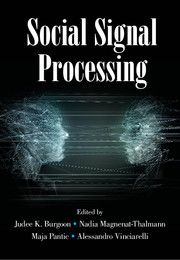Book contents
- Frontmatter
- Contents
- Contributors
- 1 Introduction: Social Signal Processing
- Part I Conceptual Models of Social Signals
- Part II Machine Analysis of Social Signals
- 11 Facial Actions as Social Signals
- 12 Automatic Analysis of Bodily Social Signals
- 13 Computational Approaches for Personality Prediction
- 14 Automatic Analysis of Aesthetics: Human Beauty, Attractiveness, and Likability
- 15 Interpersonal Synchrony: From Social Perception to Social Interaction
- 16 Automatic Analysis of Social Emotions
- 17 Social Signal Processing for Automatic Role Recognition
- 18 Machine Learning Methods for Social Signal Processing
- Part III Machine Synthesis of Social Signals
- Part IV Applications of Social Signal Processing
- References
16 - Automatic Analysis of Social Emotions
from Part II - Machine Analysis of Social Signals
Published online by Cambridge University Press: 13 July 2017
- Frontmatter
- Contents
- Contributors
- 1 Introduction: Social Signal Processing
- Part I Conceptual Models of Social Signals
- Part II Machine Analysis of Social Signals
- 11 Facial Actions as Social Signals
- 12 Automatic Analysis of Bodily Social Signals
- 13 Computational Approaches for Personality Prediction
- 14 Automatic Analysis of Aesthetics: Human Beauty, Attractiveness, and Likability
- 15 Interpersonal Synchrony: From Social Perception to Social Interaction
- 16 Automatic Analysis of Social Emotions
- 17 Social Signal Processing for Automatic Role Recognition
- 18 Machine Learning Methods for Social Signal Processing
- Part III Machine Synthesis of Social Signals
- Part IV Applications of Social Signal Processing
- References
Summary
Automatic emotion recognition has widely focused on analysing and inferring the expressions of six basic emotions – happiness, sadness, fear, anger, surprise, and disgust. Little attention has been paid to social emotions such as kindness, unfriendliness, jealousy, guilt, arrogance, shame, and understanding the consequent social behaviour. Social context plays an important factor on labeling and recognizing social emotions, which are difficult to recognise out of context.
Social emotions are emotions that have a social component such as rage arising from a perceived offense (Gratch, Mao, & Marsella, 2006), or embarrassment deflecting undue attention from someone else (Keltner & Buswell, 1997). Such emotions are crucial for what we call social intelligence and they appear to arise from social explanations involving judgments of causality as well as intention and free will (Shaver, 1985).
To date, most of the automatic affect analysers in the literature have performed one-sided analysis by looking only at one party irrespective of the other party with which they interact (Gunes & Schuller, 2013). This assumption is unrealistic for automatic analysis of social emotions due to the inherent social aspect and bias that affect the expressiveness of the emotions in a social context or group setting. Therefore, the recent interest in analysing and understanding group expressions (e.g., Dhall & Goecke, 2012) will potentially contribute to the progress in automatic analysis of social emotions.
Recent developments in social media and social websites have opened up new avenues for the employment of user-driven and user-generated emotional and affective tone such as amused, touched, and empathy in social interactions. Accordingly, a number of researchers refer to automatic analysis of social emotions as ‘social affective analysis’ (e.g., social affective text mining) (Bao et al., 2012). Such works have focused on automatic prediction of social emotions from text content by attempting to establish a connection between affective terms and social emotions (Bao et al., 2012).
- Type
- Chapter
- Information
- Social Signal Processing , pp. 213 - 224Publisher: Cambridge University PressPrint publication year: 2017
References
- 1
- Cited by



